On Saturday night, Atletico Madrid will host Barcelona at the Wanda Metropolitano stadium in a huge LaLiga clash of the 2020/21 season. Diego Simeone is yet to win his first game against the Catalan giants in the domestic league but the Rojiblancos are in red-hot form while their weekend opposition are still trying to find their feet.
This tactical analysis will serve as a preview of both teams’ tactics and their potential approaches to the derby. At the end of the analysis, we will also give your our final score predictions as well.
Predicted lineups
Accurately predicting the tactics is very difficult on its own but it suddenly becomes even more challenging in the current situation. Both squads are affected by injuries and absences, especially the hosts. Simeone cannot count on the likes of Lucas Torreira, Šime Vrsaljko nor on Luis Suárez who’s tested positive for COVID-19.
Diego Costa is also a doubt so we’ve decided not to include him in the predicted lineup. Jan Oblak received a knock during his international duties but should be back to man the sticks. In front of him, a quartet of Mario Hermoso, José Giménez, Stefan Savić (if fit) and Kieran Trippier should start. In the midfield line, we expect to see Saúl Ñíguez, Koke, Geoffrey Kondogbia getting his first start and Ángel Correa out wide.
Finally, Marcos Llorente and the star of the team, João Félix in the forward line. Atletico Madrid will likely be deployed in a 4-4-2 formation on paper.
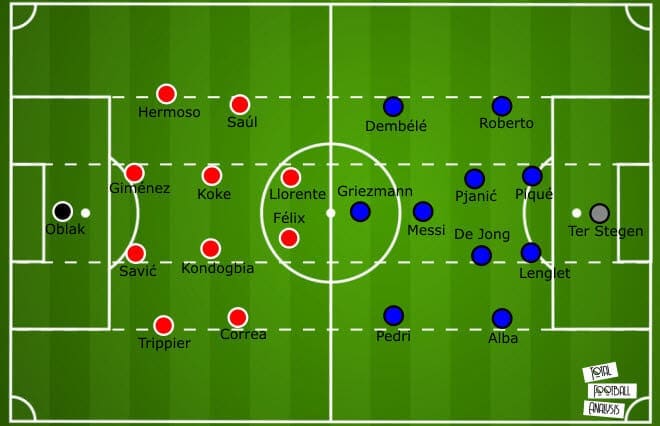
Ronald Koeman is facing issues of his own as both Ansu Fati and Sergio Busquets are confirmed to be out of the squad. However, Philippe Coutinho may return from injury just in time to participate and the rest of the squad is mostly fit. Marc-André ter Stegen will surely start in goal with Jordi Alba, Clément Lenglet, Gerard Piqué and Sergi Roberto completing the defence.
In midfield, Frenkie de Jong is likely to be partnered by Miralem Pjanić and Koeman could deploy Lionel Messi just in front of them in that no.10 role. Despite Coutinho potentially returning to full fitness, Pedri seems like the safer option at the moment on the left side. On the right, Ousmane Dembélé might get a start in a huge clash and Antoine Griezmann will face his former time from the sole striker position.
We expect Barcelona to assume a 4-2-3-1 system for the night.
Atlético Madrid’s attacking tactics vs Barcelona’s defence
The first section of this tactical analysis will deal with Atlético Madrid’s tactics when in possession. Even though Simeone likes to deploy his troops in a 4-4-2 both in attack and defence, their offensive structure shifts to a 3-4-3 when on the ball.
However, their main approach will heavily depend on the personnel selected. I feel like they will go with an extra midfielder in Kondogbia and then push Saúl out wide to the left instead of going with two wingers and a forward. Saúl is a more conservative option when shifted towards the flanks but will keep the width and provide the link-up well.
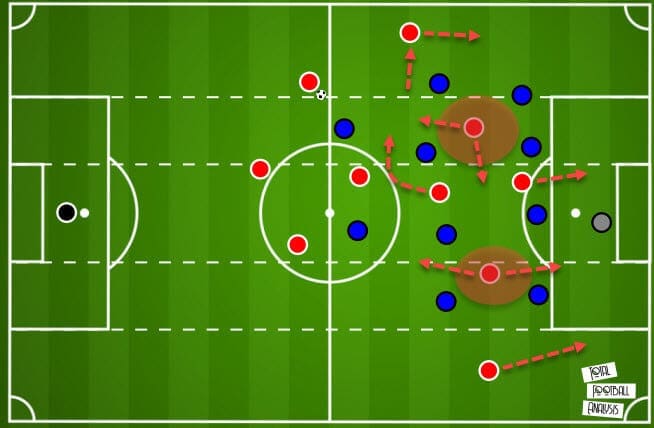
Above, you can see what their shape might look like against Barcelona’s trademark 4-4-2 mid-block. Félix is of course the focal point of their attack and he’ll be in a free role across the final third. With no strikers available, Llorente will be tasked to occupy the centre-backs and offer runs in-behind the defensive line. Correa, on the other hand, can interchange positions with Llorente and try and find pockets of space between the lines.
And this is the main tactical approach Simeone has adopted in attack – occupying the space between the lines and then build from those pockets. Usually, if they play with two wingers, both will cut inside and position themselves around that area, allowing for central overloads and easy link-up with the forward.
As soon as the players can be found in those pockets, it activates the runs of their teammates. You can see a similar example below in the game against Cádiz. Once Correa can receive between the lines, it immediately triggers the runs from three or four different sources.
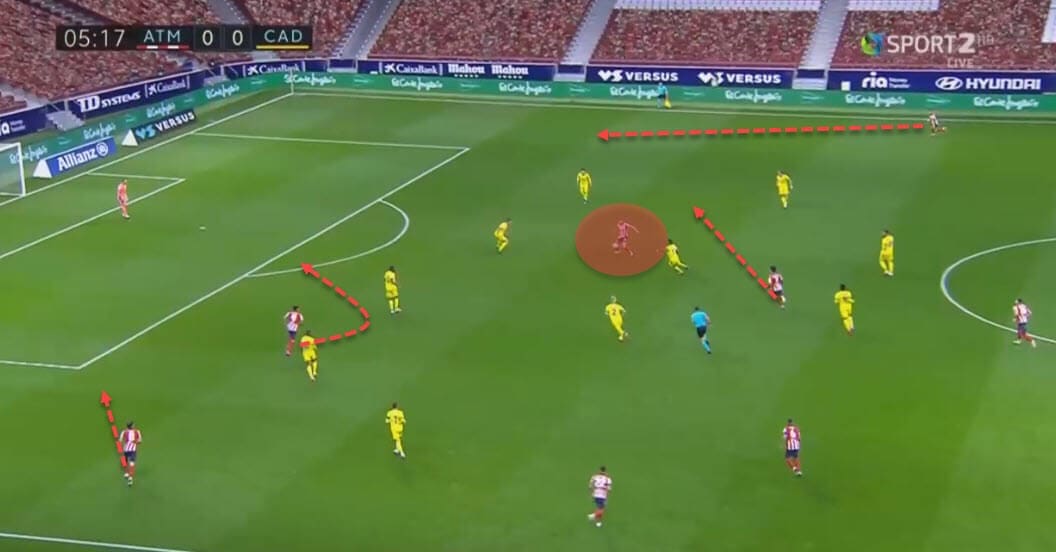
The winger or midfielder in that position can then easily send a ball over the top or just break the lines and deploy a pass into space behind. These runs will be crucial against Barcelona’s slow defensive structure and transitions. And even though Atlético Madrid often go through the central areas, we’ll likely see them exploit the flanks against the Catalans’ often narrow structure.
This is particularly true for the right side where Tripper will combine with Correa. If Simeone goes for Saúl as the wide option on the left, paired with Hermoso, that flank will mostly be overly defensive so an asymmetrical approach is likely. There is an option of going with Yannick Carrasco on the left, Llorente through the middle, Correa on the right and Félix just behind of them but that sounds overly aggressive for such a big clash.
Below is an example that illustrates the occupation of space between the lines and the trigger for runs in-behind the opposition’s defence perfectly.
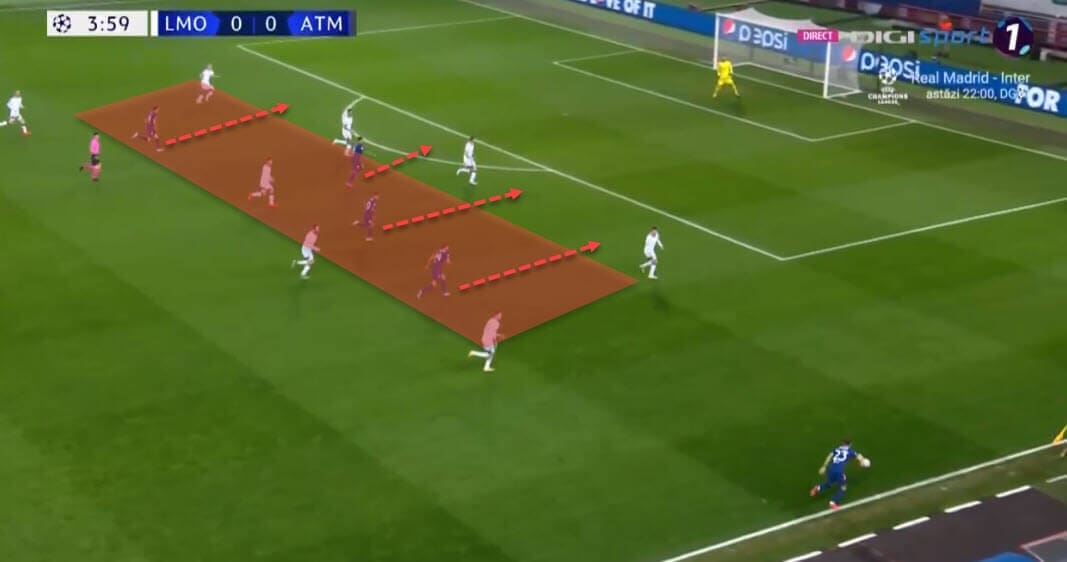
But there are more advantages to this approach. We’ve mentioned how it lends itself perfectly for central overloads and this could also be an effective way to bypass Barcelona’s press. The Catalans will often press in a 4-2-3-1 that transforms into a 4-1-4-1 or a 4-3-3. However, a distinct feature is pushing one pivot higher and keeping the other deeper.
We’ve seen teams already capitalise on this by overloading the other pivot who stays in that deeper area. All it takes is for a forward to drop and combine with his midfielder to create a 2v1 situation which helps the build-up immensely.
The following example shows us Barcelona’s general approach to pressing where the 4-2-3-1 becomes a 4-1-4-1 and also the difference in positioning between the pivots.
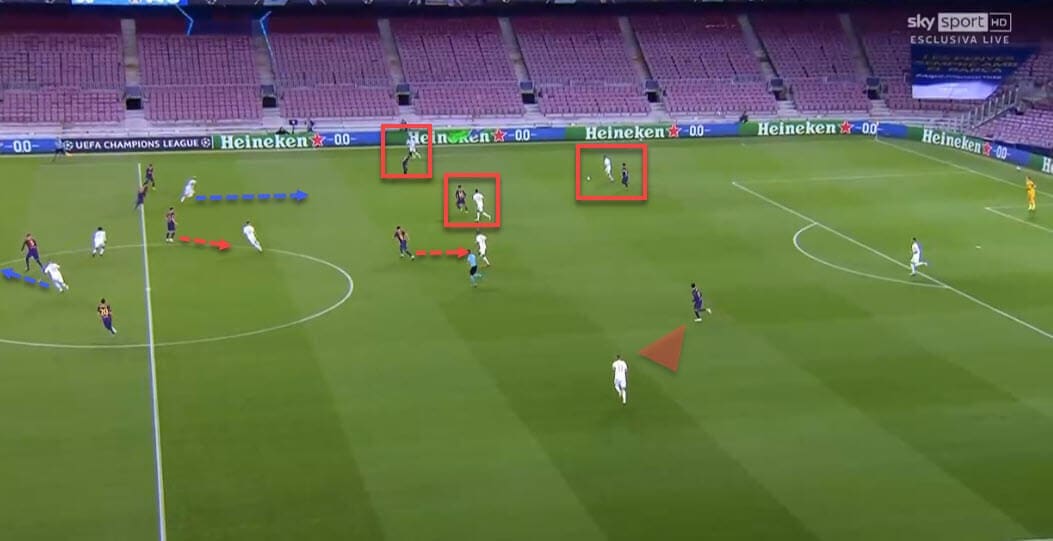
And the next image depicts how teams can make use of that to overload the deeper midfielder. Once the three-man backline has attracted a player from the opposition’s second line, there’s an opening to create a numerical superiority behind their backs.
In the instance below, this is exactly what the opposition have done to Barcelona, albeit they couldn’t really make use of it properly.
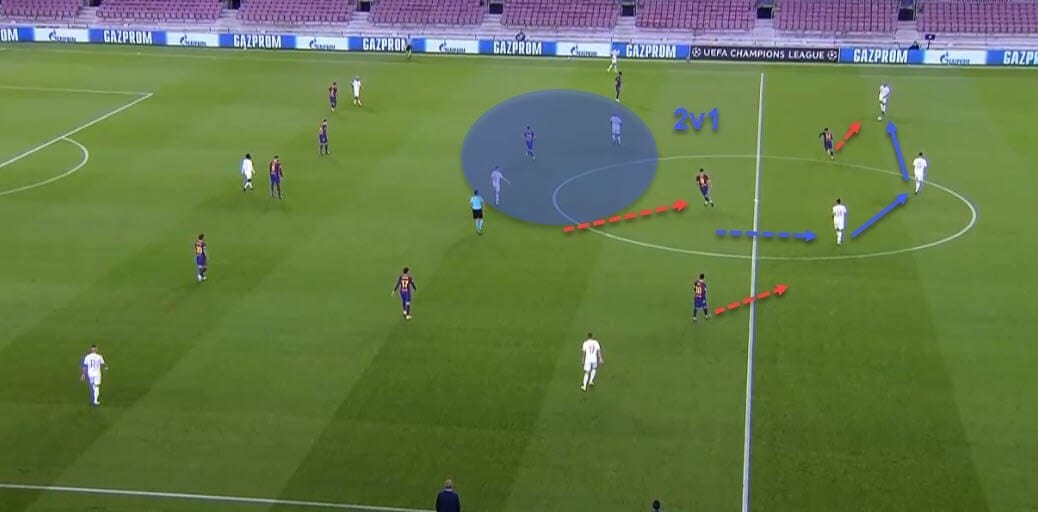
The final aspect that’s worth mentioning is the decisional crisis Atlético Madrid’s space occupation creates against the opposition defenders. With players constantly between the lines, it forces the centre-backs to decide whether to push up and mark the player tightly, risking leaving loads of space behind, or leave him unmarked and keep the structure intact.
And when you’re playing against the likes of Piqué and Lenglet, both of whom can be extremely aggressive in their man-marking, there’s certainly an opening there to manipulate their movement to access the space behind.
Below we can see a clear example of that against Real Betis as Piqué follows his man higher up, which immediately triggers the runs of two players.
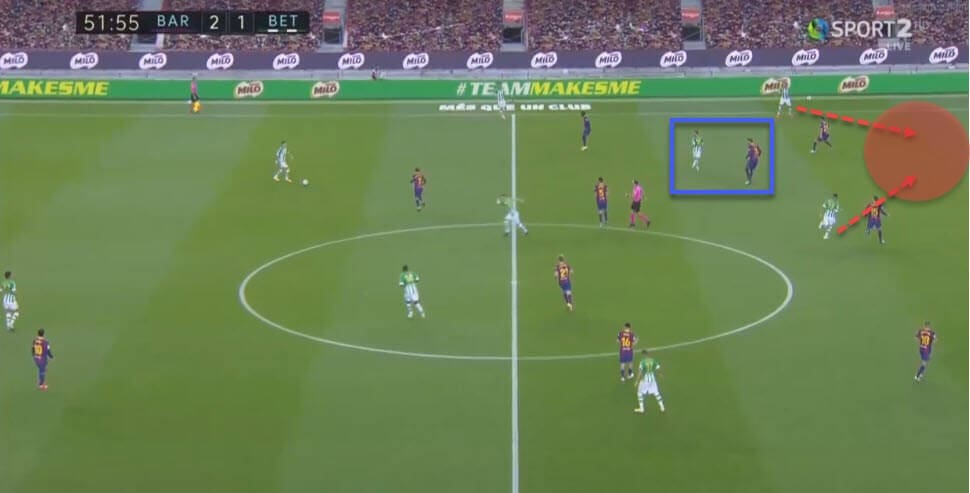
A well-placed pass over the top and into runners could see the hosts capitalise on this flaw in Barcelona’s defensive system.
Barcelona in possession vs Atlético Madrid’s defensive tactics
Now with Atlético Madrid’s attacking tactics out of the way, we can focus on the reverse – Barcelona on the ball and how the host might set up in defence. Since Simeone is likely to stay faithful to his trademark 4-4-2 out of possession, we can expect Barcelona to counter it in one of two ways: De Jong dropping into the backline to create a 3v2 numerical superiority or keeping the pivot between the two centre-forwards to give the centre-backs an additional passing option.
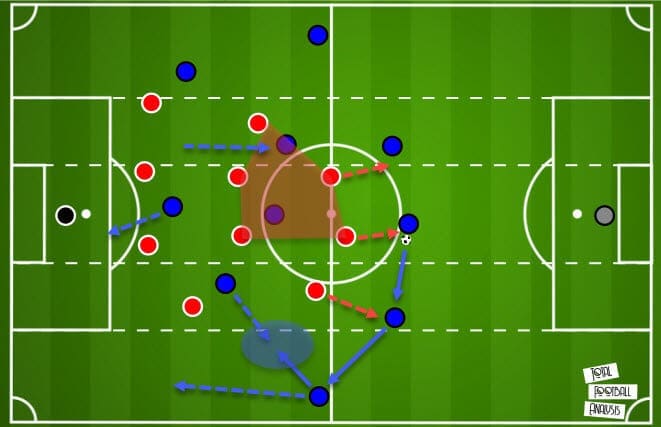
Above, you can see how the two teams’ structures might interact with each other. Atlético Madrid are one of the best defending teams on the planet and yet, their tactics are usually rather simple but effective. The foundation of their 4-4-2 mid-block lies in vertical compactness and solidity.
Notice how they aim to shut down the access to the central channels, forcing the opposition wide. This could be especially effective against Barcelona, who are still among the most central teams when it comes to attacking tactics. The idea is to direct the ball towards the flanks where they can establish superiority and then collapse on the carrier.
Below, you can see a fairly usual 4-4-2 structure Atlético Madrid deployed against Lokomotiv Moscow.
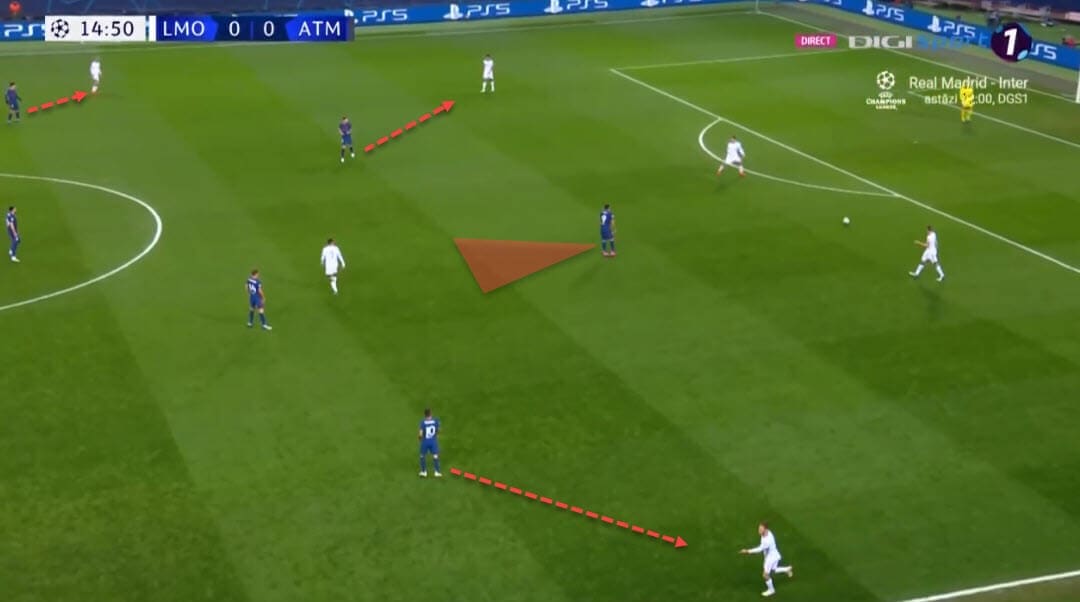
That game itself is a very good blueprint for Saturday’s clash precisely because Lokomotiv used a three-man backline in the build-up phase against the Spaniard’s two-man frontline. In such a scenario, the forwards will often track the ball with moderate pressure and aim to keep the central options in their cover-shadow.
The wide midfielders are tasked to mark the full-backs in tandem with their own full-backs while the central midfielders stay tight to the opposition’s central options. You will notice that Simeone likes to keep a distinct man-marking approach in the middle third and this is often where Atlético Madrid get most aggressive in their press.
Note down below how that sequence often goes. Lokomotiv try to recycle the ball wide towards their full-backs. In this instance, as can often be the case, Félix will stay tight to the pivot while the other centre-forward makes an angled run to block off the ball-carrier’s backwards option.
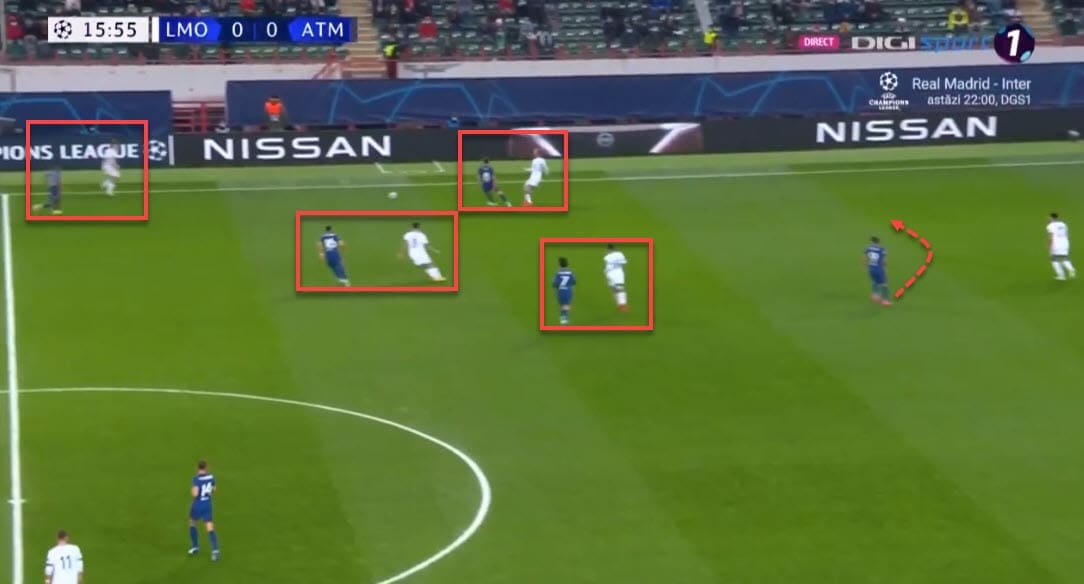
And that example also clearly depicts the man-marking approach we’ve mentioned earlier in the tactical analysis. Once Suárez drifts wide from the forward position, Atlético Madrid can create a 5v4 situation on the flank and successfully suffocate the opposition until they snatch the ball away.
This is an effective strategy that they often deploy, especially in the middle third where their press is often the most aggressive. Generally speaking, they are rarely pressing high up the pitch and will rather stay compact and narrow than risk getting disorganised and disjointed when venturing too far forward.
When Bayern Munich put four past them in the Champions League, it was mostly because they were able to find gaps between the lines where their forwards received the ball in space. This, along with the potential for overloads, could be their undoing against Barcelona. Interestingly, despite them mostly staying vertically compact at all times, there are instances when gaps can appear.
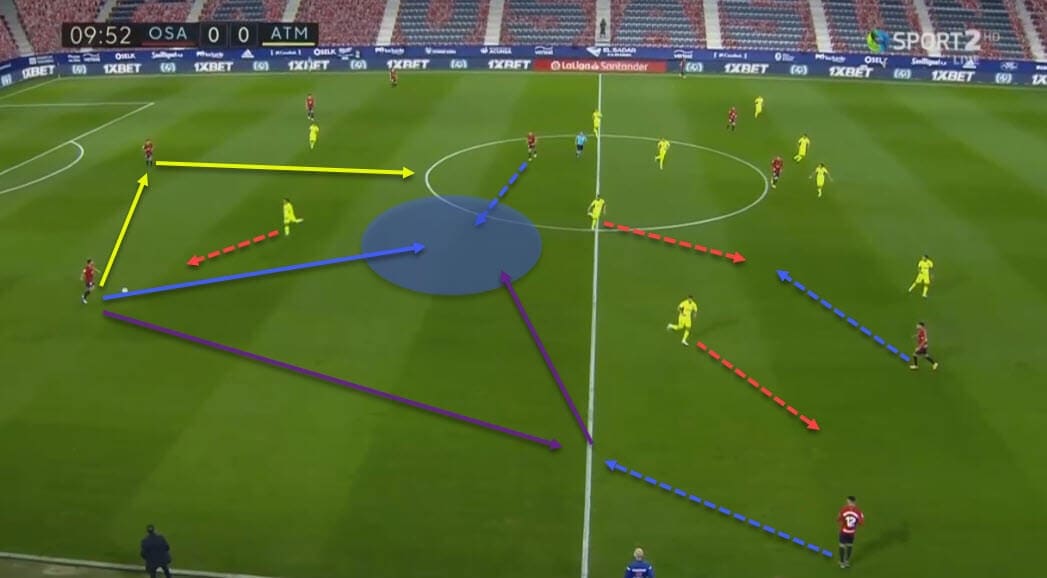
Above is an example from the clash against Osasuna which can help us highlight these issues. We’ve mentioned how Atlético Madrid don’t usually press that high but they do have certain press triggers that prompt them to move forward. The most general trigger is a backwards pass and in that scenario, we can see them move up as a compact unit and the Rojiblancos will often throw a lot of players into the press.
However, this is when the problems start appearing. Essentially the only instances when Atlético Madrid lose their compactness is when the opposition manage to draw them out of their standard structure. Above, we can see Osasuna in a three-man backline and with three different options to beat the initial press and access the space between the lines.
Each colour represents one pattern that could see them progress the play and because the defending team is too stretched out, they can easily advance up the pitch. This could certainly be an issue against Barcelona as the Catalans enjoy inviting pressure and then bypassing it. Both Pedri and Messi are excellent in positioning themselves in those pockets of space and are then easily found by the excellent ball-playing centre-backs in Piqué and Lenglet.
Interestingly, as mentioned earlier in this tactical analysis, Bayern used similar tactics to both create and exploit space. Notice below such an example.
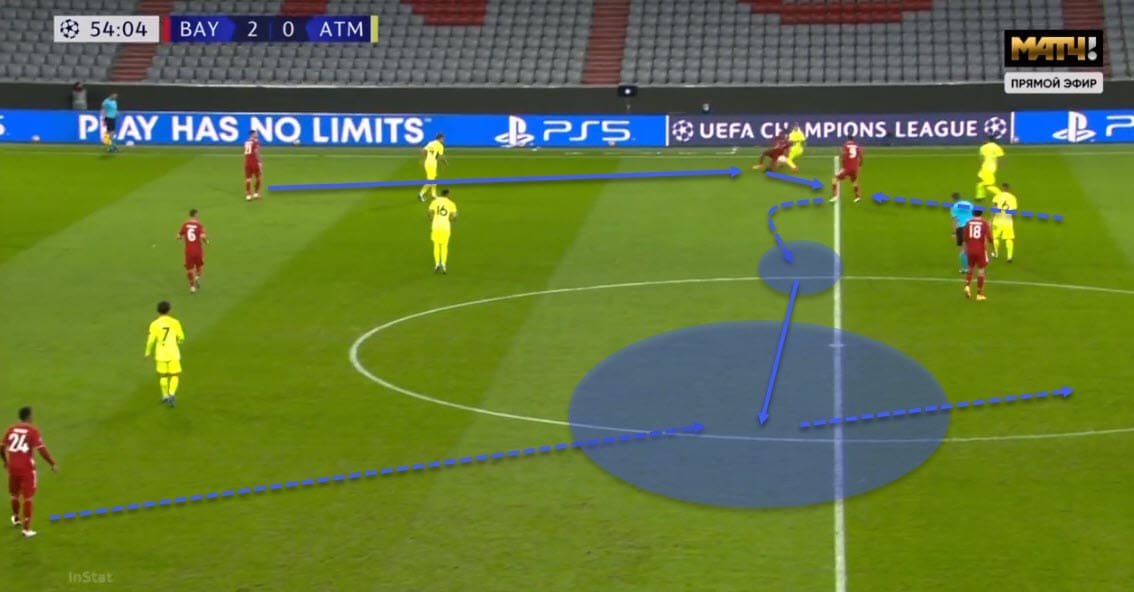
As the ball is moved from the right to the left side and over to the full-back, Robert Lewandowski drops deeper to act as a link-up player in-between the lines. The ball is quickly relayed to him and he receives the pass in acres of space because Atlético Madrid are once again too stretched out as soon as they commit men forward.
The Polish striker then quickly switches sides to send Corentin Tolisso into space. We’ve seen Barcelona do similar things with the likes of Messi and Pedri dropping into those same pockets to then send the ball out wide and into space, as can be seen in the initial graphic at the beginning of this section.
Finally, this can also be used to create overloads on Atlético Madrid’s midfielders. Below is an example of how Barcelona may look to accomplish that.
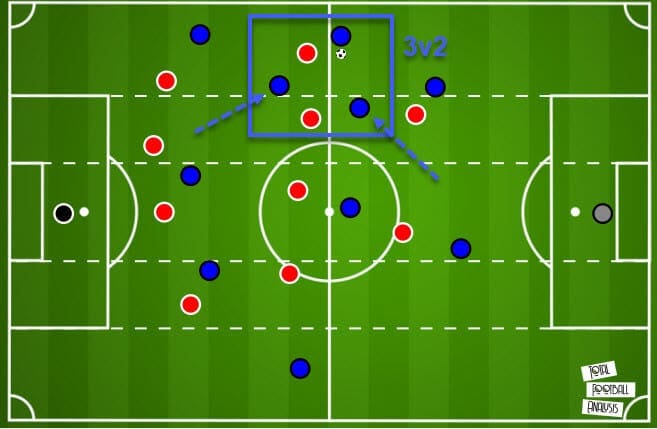
The principle is based on the fact that Simeone won’t always send a man from the second line to combat the 3v2 numerical inferiority in the first line and will sacrifice it for vertical compactness in a narrow mid-block.
However, with the wide midfielder pressing the full-back and the central midfielder moving up to mark the dropping forward, the opposition’s pivot can move out from the backline back into midfield to establish numerical superiority out wide.
Since the striker will be preoccupied with cutting the passing lane back to the centre-back, this leaves the attacking team in an advantageous position. Teams like Osasuna or even Lokomotiv Moscow have used this to aid the build-up phase and it seemed to work well.
You can see a similar example down below where Osasuna establish numerical superiority by moving their midfielder wide in this case and having the forward make a run in-behind.
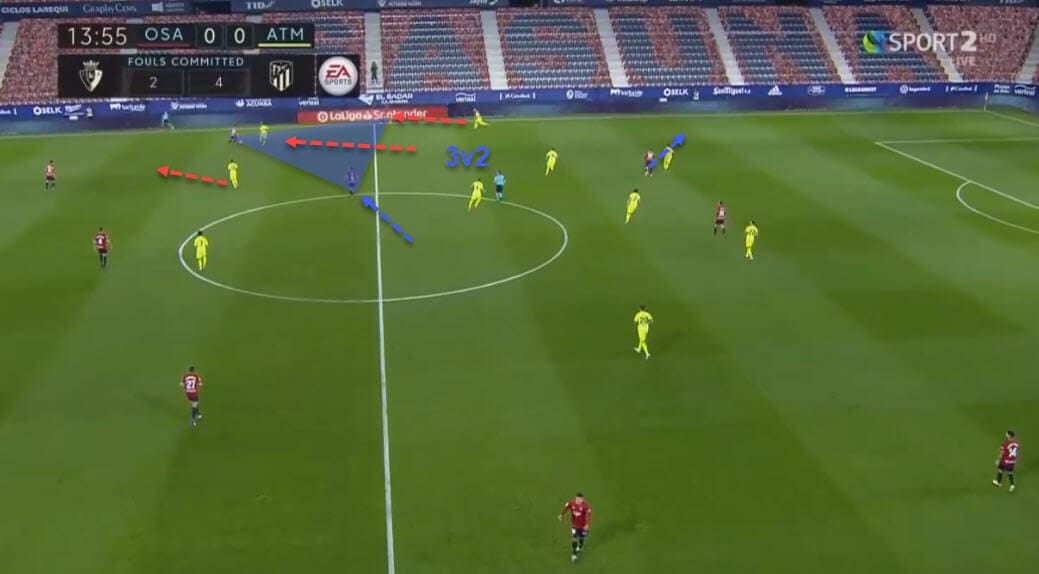
There is no reason why Barcelona could not do the same thing.
Final predictions
We’ll finish this tactical analysis by giving our final prediction for the clash. Atlético Madrid are in red-hot form and their new attacking tactics could see them finally edge past Barcelona in LaLiga.
It’s difficult to bet against the Catalans with their immaculate record facing the Rojiblancos but we’ll go with a 2-1 victory for the hosts.






Comments